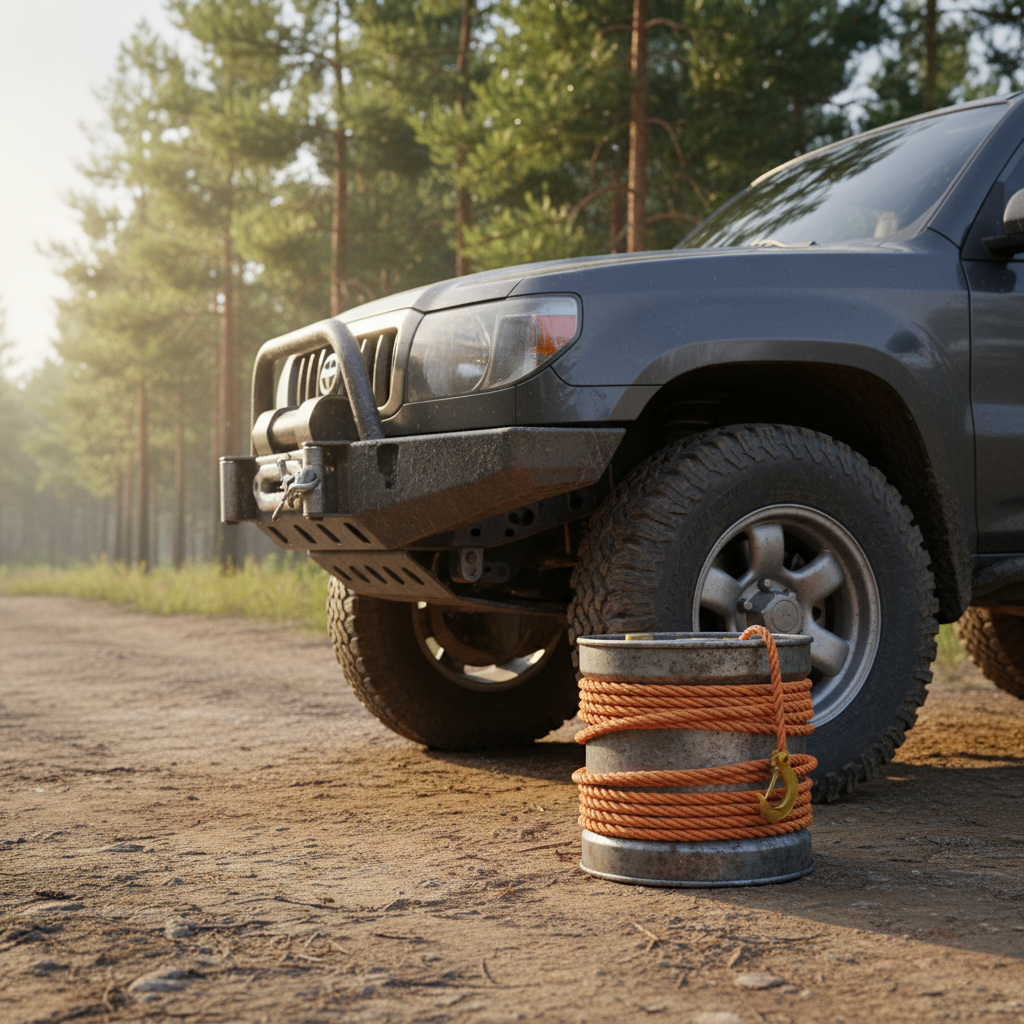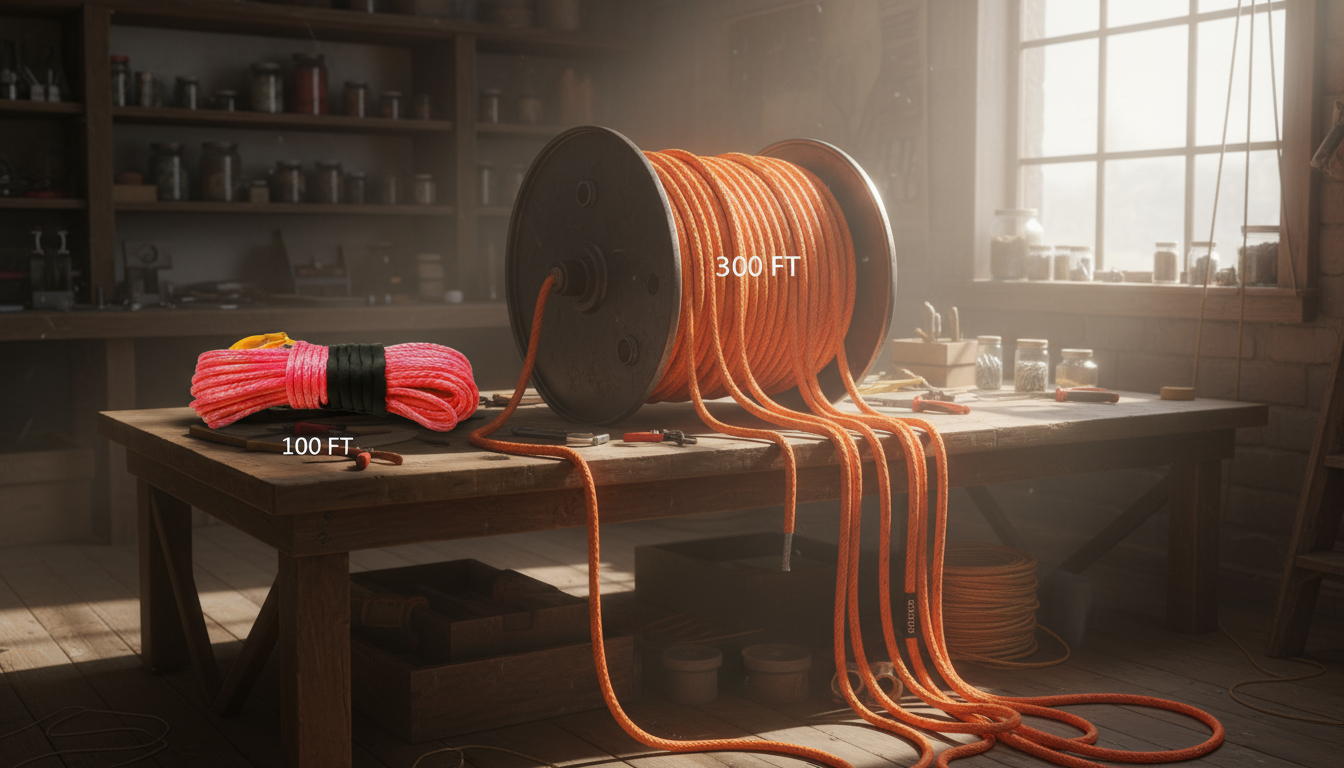A 300‑ft rope gives you 50% more reach than a 200‑ft line. Using HMPE synthetic at roughly 0.08 lb/ft, the extra 100 ft adds about 8 lb—so you can reach farther without extra rigging in many scenarios.
Key Benefits – 4 min read
- ✓ Extend pull distance by up to 100 ft, reducing the need to reposition or re‑spool mid‑job.
- ✓ Optimise drum performance by maintaining sufficient layers for smoother control during long pulls.
- ✓ Access cost‑effective, bulk‑cut lengths through iRopes’ wholesale pricing and OEM/ODM services.
- ✓ Get ISO 9001‑certified custom cuts, colours, and branding, specified to fit your winch correctly.
Longer lines add weight and extra layers on the drum, but modern synthetics help keep systems efficient. For example, HMPE synthetic weighs about 0.08 lb per foot at 3/16 in, far lighter than steel. Whether you need a 200 foot rope or a 300 foot rope, matching diameter and winch capacity preserves performance and safety. The sections ahead explain the maths, the right winch specs, and the custom‑order steps that make choosing the ideal length straightforward.
200 foot rope – Core Basics and Applications
After looking at why rope length matters for winch performance, it’s time to focus on the 200 foot rope itself. This length strikes a balance between manageable drum space and enough pull distance for many everyday recovery scenarios.

A 200 foot rope is simply a line that measures exactly 200 feet from end to end. Manufacturers offer a range of diameters, each suited to different load requirements and industry standards. Choosing the right diameter is the first step in ensuring safe, efficient operation.
- 3/16 in diameter – common for light‑weight off‑road winches and small marine anchors.
- 1/4 in diameter – preferred in mid‑size industrial lifts where a higher breaking strength is needed.
- 5/16 in diameter – used in heavy‑duty applications such as construction hoists and larger recovery rigs.
How does that length affect the winch? On a typical 12‑inch drum, a 200 foot rope often occupies around two to three layers, depending on rope diameter and drum width. Fewer layers increase effective pull on the first wraps, which helps during the initial metres of a recovery.
Key applications for a 200 foot rope include:
- Off‑road recovery – enough length to reach a stuck vehicle while keeping the drum light for quick rewinds.
- Marine anchoring – provides a reliable line for medium‑size yachts that need a sturdy, UV‑resistant pull.
- Light industrial lifts – ideal for hoisting pallets or equipment where space around the winch is limited.
“Our engineers can cut any rope to an exact 200 ft length, add custom colour or branding, and still meet ISO 9001 quality standards – a combination that’s hard to find elsewhere.” – Lead Engineer, iRopes
When you order from iRopes, the 200 foot rope can be customised to your exact specifications – from material choice (HMPE, polyester, nylon) to colour, pattern, and pre‑spliced loops or thimbles that match your winch’s attachment points. iRopes also offers non‑branded or customer‑branded packaging (bags, colour boxes, or cartons) and protects your IP from design through production, with pallets shipped directly worldwide.
If you anticipate needing more reach or multiple layers on a larger drum, the next step up is a 300 foot rope, which offers extended coverage without sacrificing strength.
300 foot rope – Advantages of Extended Length
When the job calls for extra reach or you need several layers on a larger drum, the extra 100 feet can change the whole recovery strategy. A longer line lets you pull farther without repositioning, and it reduces how often you must re‑spool.

Here are the three most compelling reasons to choose a 300 foot rope when the situation allows:
- Greater reach – you can engage a stranded vehicle or anchor point beyond the 200 ft limit without moving the winch.
- Maintain multiple layers – on larger drums you keep more layers under tension, which spreads load more evenly and improves control.
- Reduced re‑spooling – the longer line stays in service longer, meaning fewer interruptions and less wear on the spooling mechanism.
Because the rope is longer, the line’s own weight contributes more to the total system load. Engineers typically apply a safety factor of 1.5 × the expected load; include rope weight and drum layering in your calculations to stay within that margin.
Custom 300 ft Solutions
iRopes can cut any rope to an exact 300 ft length, then finish it in the colour, pattern or branding you require. Whether you prefer HMPE for lightness, polyester for UV resistance, or a high‑visibility orange sheath, the factory‑cut ends are ready to splice directly onto your winch.
Imagine you’re on a remote trail and the vehicle you’re pulling sits just beyond the reach of a 200 ft line. With a 300 foot rope you can stretch that extra distance, keep sufficient layers on the drum for smoother braking, and continue the pull without pausing to rewind. That flexibility often translates into safer recoveries and less wear on both the winch and the rope.
Now that you see how the extended length influences performance, the next step is to verify that your winch can accommodate a 200 ft cable configuration before you decide which rope best fits your overall project.
winch with 200 ft of cable – Compatibility Checklist
After exploring why a longer line can be useful, the next logical step is to confirm that your winch will actually accept a 200 ft configuration without compromising safety or performance.

When you match a winch to a 200 ft line, three technical pillars determine whether the pairing will run smoothly: the drum’s physical dimensions, the motor power and duty cycle, and the first‑wrap rating that tells you how much load the rope can safely handle on its initial coil.
- Drum size & layer capacity – A 12‑inch drum often accommodates two to three layers of a 200 ft rope, depending on rope diameter and drum width; larger drums hold more.
- Motor power & voltage – Match 12 V/24 V/DC or AC power and motor output to your load and duty cycle, ensuring adequate cooling and line speed.
- First‑wrap rating – Choose a winch whose rated pull is 1.5 × the anticipated load; this safety factor accounts for rope weight and dynamic forces.
Many large‑drum recovery, marine and industrial winches can be configured to accept 200 ft of cable by selecting the appropriate rope diameter and construction. Always check the manufacturer’s drum‑capacity chart and confirm first‑wrap limits before ordering.
Installation tip: use factory‑cut ends or a certified splicing method to avoid weak points; a clean splice preserves the rope’s breaking strength and keeps the winch’s load rating intact.
Remember, a 200 foot rope is not just a longer piece of line – it adds weight that the winch must lift as the rope builds up on the drum. Accounting for that extra mass in your load calculations will keep the safety factor realistic and the winch operating within its design limits.
With the checklist above, you can quickly verify whether your existing winch or a new purchase will handle a 200 ft cable without compromising durability or safety. The next step is to weigh the project’s overall requirements and decide which rope length delivers the best value for your application.
Choosing the Right Rope Length for Your Project
Now that you’ve confirmed which winches can actually accept a 200 ft cable, the next step is to decide whether a 200 foot rope or a 300 foot rope gives you the best blend of reach, cost and durability for the job at hand.

Think of the choice as a decision matrix: the shorter line keeps the drum light and the price per foot low, while the longer line reduces the number of rewind stops on larger drums. Below is a quick visual guide that lines up the most common considerations.
200 ft Rope
Compact & Cost‑Effective
Light drum load
Less rope weight means the winch motor works against a smaller mass, preserving pull on the first layers.
Lower cost per foot
Synthetic ropes generally cost less per foot than steel of equivalent rating, and volume orders further reduce unit cost.
Easier storage
Shorter coils fit into tighter lockers and are quicker to unwind when you need them.
300 ft Rope
Extended Reach
Greater pull distance
You can reach targets that sit beyond the 200 ft limit without moving the winch or adding extra spools.
Fewer re‑spool cycles
Longer line stays in use longer, cutting down on drum wear and the downtime of rewinding.
Better load distribution
More layers on a larger drum spread the tension more evenly, improving braking control.
If cost is the primary driver, the ranges speak for themselves. Retail pricing varies by material, diameter and construction: a 200 ft synthetic rope can range from about $20 to $300, with a 300 ft equivalent proportionally higher. A 200 ft steel cable often falls between $300 and $1 200 at retail. iRopes provides bulk pricing and cost‑effective OEM solutions for wholesale orders.
“Retail prices vary widely by spec. As a guide, a 200 ft synthetic rope may cost $20–$300, while steel options of the same length often sit in the $300–$1 200 bracket. Our bulk‑order pricing helps keep your cost‑per‑foot competitive.” – Pricing Analyst, iRopes
Beyond raw numbers, iRopes’ OEM/ODM workflow turns a simple length request into a fully branded product. You start by selecting material—HMPE for ultra‑light weight, polyester for UV resistance, or steel for maximum abrasion tolerance. Next, you choose colour, pattern, and any accessories such as pre‑spliced loops or thimbles. Our ISO 9001‑certified line then cuts the rope to the exact 200 ft or 300 ft specification, applies your branding, protects your IP, and ships it in the packaging you prefer—non‑branded or customer‑branded bags, colour boxes or cartons—with pallets delivered directly to your location worldwide.
Lastly, remember that a longer rope demands a slightly different maintenance rhythm. Inspect the line at least every 100 pull cycles or monthly, looking for abrasion, UV fading or fibre fraying. Clean synthetic ropes with mild soap and warm water; steel cables benefit from a light oil coat to stave off rust. Consider sleeves or chafe guards for abrasion zones. Store the rope loosely coiled in a dry, shaded area to avoid kinks that could become weak points later.
With the matrix, cost breakdown and upkeep plan in front of you, weighing a 200 foot rope against a 300 foot rope becomes a straightforward calculation of reach versus budget—and the choice that best fits your project’s unique demands.
By now you’ve seen how a 200 foot rope offers a compact, cost‑effective option with a lighter drum load, while a 300 foot rope delivers extended reach and fewer re‑spool cycles for demanding recoveries. iRopes can cut either length to exact specifications, add colour or branding, and ensure ISO 9001 quality, so you can match the rope to your winch and project requirements. Remember to check the compatibility checklist for a winch with 200 ft of cable to keep safety factors in check. Whether you prioritise budget, reach or durability, a custom‑cut rope from iRopes will fit your exact needs.
For more in‑depth advice on selecting the ideal winch line, check out our Ultimate Guide to Choosing the Best Winch Line.
Ready for a custom‑cut solution?
If you’d like personalised guidance to select the ideal length, material and accessories for your application, simply fill out the form above and our rope specialists will get back to you.